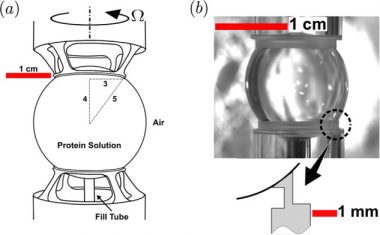Space Experiment Could Shed Light on Neurodegenerative Diseases
Written by |

Lia Koltyrina/Shutterstock
Researcher Amir Hirsa has found a way 240 miles above the Earth’s surface to study the aggregation of proteins that are the hallmarks of Alzheimer’s and Parkinson’s diseases, and type 2 diabetes.
Hirsa, PhD, is a professor of mechanical and aerospace engineering with a joint appointment in chemical and biological engineering at Rensselaer Polytechnic Institute (RPI) in Troy, New York. He and his team of graduate students and postdoctoral fellows are studying this process through a series of experiments being conducted aboard the International Space Station (ISS). They are using insulin, which is relatively inexpensive to acquire and often used as a model to study amyloid formation, or fibrillization.
Next in line could be the alpha-synuclein protein and beta-amyloid protein, the aggregation of which are found in the brains of Parkinson’s and Alzheimer’s patients, respectively. Studying how these proteins clump together could help scientists understand the processes behind the development of these neurodegenerative diseases.
“The call for proposal came, and I had a moment of insanity or inspiration or whatever you want to call it,” Hirsa said in a video interview with Alzheimer’s News Today of the precursor idea to the present-day experiment. “I thought, ‘Nobody’s ever done this before.’”
Space provides an ideal environment to examine the formation of these protein clumps without the interference of containers. On Earth, these experiments must account for how the solid walls of a container may be affecting the process. In the absence of gravity in space, water molecules can come together freely and form a free-floating sphere without need of a container. The fluid dynamics of insulin dissolved in that sphere of water more closely mimic that of the fluid interfaces in the body.
“One of the big reasons you want to go into microgravity is because, other than bones, there are no truly solid interfaces in the human body,” Joe Adam, a postdoctoral researcher in Hirsa’s lab, said in a press release from RPI. “The surfaces of your cells, your neurons, and your brain, are fluid interfaces. So, if we can get a system that has more of those fluid interfaces, it will help us to understand the science behind these fibrillization processes.”
A specialist in fluid dynamics for more than 30 years, Hirsa designed a device called a “ring-sheared drop” that can hold a sphere of water in place while subjecting it to a shearing force, in which the top and the bottom of an object are forced in opposite directions. Shearing force also is present in the body, as liquids move past each other in different directions and at different velocities. One of Hirsa’s recently published studies shows that shearing force causes aggregation of the insulin protein.

A schematic of the ring-sheared drop. (Courtesy of NPJ Microgravity)
The ring-sheared drop is made up of rings on polar ends facing each other. A tube below the southern pole slowly releases the protein solution until it comes in contact with the opposite ring, and within one minute, a sphere held together by surface tension is formed.
The second ring then rotates at 30 revolutions per minute to model the shearing force that occurs in the human body. Some of the samples go through this process on Earth before being sent to space, albeit with slightly different equipment because of gravity’s constraints. Hirsa refers to it as “pre-treatment.” Pre-treated samples are held in the ring-sheared drop in space for four days; non-treated for 10 days.
The research group has successfully run six test cases on the ISS since the experiment started in earnest in early August. On Sept. 14, the first test began for the non-treated insulin solution, which will allow scientists to observe from start to finish how amyloid formation might occur in the brain.
“Watching the protein go through its entire fibrillization process in space is the most exciting,” Hirsa said.
“In the first time points, there’s nothing, we don’t see any clumps of fibers. And at the very end, there’s lots of fibrils and this is one of the best pictures for relating the plaques in the brain to Alzheimer’s, Parkinson’s, and all those kinds of amyloid diseases,” Adam said.
It takes a village to perform the full experiment on the ISS. The researchers cannot communicate directly with astronauts; rather, the Johnson Space Center sends up instructions for crew members to operate the ring-sheared drop. Hirsa estimates that 10 people from NASA, Teledyne-Brown Engineering, and RPI, all looped together in a call, oversee the setup.
Once the insulin solutions complete the shearing process, they are frozen and prepped for their return from orbit, where the fibrillization process can be studied closely. Hirsa expects the first specimens to arrive via SpaceX rocket at the end of September.
Hirsa received two grants from the Marshall Space Flight Center to conduct his research and experimentation. The center also provided flights that follow a parabolic line to simulate zero-gravity for testing. Teledyne Brown Engineering manufactured Hirsa’s ring-sheared drop design to run the experiment in space.
The initial idea for the ring-sheared drop didn’t come until 2013 when Hirsa’s Marshall Space Center grant began, and he was thinking of ways to create a containerless biochemical reactor. While the insulin experiment is the first to make use of this device, once Hirsa publishes this study, he hopes to use it to model the flow of transport proteins and other processes in the body’s liquid interfaces.
Beyond that, there is almost limitless potential for experiments using the ring-sheared drop. One such example is testing the stability of pharmaceutical compounds before they’re used in humans. Another is creating a surface on the sphere that models the cellular membranes in the body.
“This is just one brick in a giant wall,” Hirsa said. “We’re not claiming to understand or model what happens in human physiology but trying to understand the relevance of shear forces in the interior of the liquid passage versus the surface of that liquid passage.”





